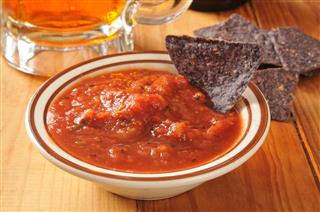
There seems to be a tremendous amount of confusion about the variety of sauces available in the Mexican food aisle. But with this Tastessence post, you will understand the difference between salsa, picante sauce, and pico de gallo once and for all.
Serve bread with everything.
The Spanish people believe in taking time to enjoy their meals with family and friends, and always keep bread on the table. As majority of their dishes have some kind of sauce (either prepared in it or served on the side), the bread helps pick up all the extra sauce that’s left behind.
It is said that corn and beans are the basis of Mexican cuisine and diet, but we believe it’s the salsa that makes it all taste so wonderfully delicious. Take any dish ― chilaquiles, burrito, tacos, tortilla chips, tostadas ― a bowl of red or green salsa will always accompany it. And once you’ve had the glorious opportunity to taste traditional Mexican food, the fast food and supermarket imitations of ‘salsa’ just won’t cut it.
But our interest today does not lie in whether the fresh salsa tastes better than the one available in jars. We are here to discuss something far more important ― are salsa, picante sauce, and pico de gallo different from one another? And if yes, then how? As you read the article, you will find authentic recipes for both picante sauce and pico de gallo along with their proper descriptions.
What is Salsa?







In most English-speaking countries, the variety of sauces available in the supermarkets are presumptuously called salsa. So, what does it actually mean? In Spanish, salsa basically means ‘sauce’. It is a condiment made with red tomatoes or tomatillos in two forms―raw or cooked―and is served as either a dip or accompanied with a dish. So, in a broader sense, the different types of sauces, thin, chunky, smooth, spicy, mild, green, black, etc., all fall under the category of salsa. There is no single recipe or ingredient that can claim itself as salsa; it’s a generic term.
What is Picante Sauce?
In Spanish, the word ‘picante’ means ‘spicy’. If you pay attention to the Mexican food aisle, where they have all the different types of salsa available, you will find some picante sauce labeled as ‘salsa’. This is not wrong. Keeping the original meaning of the word ‘picante’ in mind, this variety simply means it is a spicy salsa. One way to distinguish picante sauce from other types of salsa is by looking at its texture. It comes in a semi-liquid form and is prepared by cooking the ingredients.

Serving size – 3 cups
Cook time – 15 mins
Ingredients
- Vine tomatoes, 1¼ lb.
- Water, ¼ cup
- Cilantro, chopped, 2 tbsp.
- White vinegar, 1 tbsp. + 1 tsp.
- Garlic cloves, 3
- Jalapeños, no stems, 2
- White onion, wedges, ½
- Salt, for taste
Directions
- Preheat the broiler at least 5 minutes before cooking.
- Take a rimmed baking sheet and place tomatoes, jalapeños, onion, and garlic cloves in.
- Place the baking sheet over the hot broiler and let the vegetables cook for about 5 minutes or so.
- Keep turning the vegetables as often as you feel like (so it doesn’t stick to the sheet).
- Once you see the tomatoes blister and release juices, remove the sheet off the broiler and keep it aside to cool down.
- First, take the garlic cloves, peel the skin, and place it in a blender; next, add the other vegetables in.
- Add white vinegar, water, and a little bit of salt, and blend the ingredients until it turns smooth.
- Do a taste test to see if you need to add any more salt (you can add lime juice as well).
- Pour picante sauce in a bowl, garnish with chopped cilantro, place a cover on top, and serve either warm or chilled (refrigerate for 30 minutes).
What is Pico de Gallo?
This uncooked salad prepared with diced ingredients is also known as salsa fresca, salsa picada, and salsa mexicana. It is another type of salsa with a chunky texture as the ingredients are chopped/diced instead of being cooked or blended together.
Serving size – 2 cups
Cook time – 10 mins
Ingredients
- Tomatoes, 2
- White onion, ½
- Serrano pepper, 1
- Cilantro, chopped, 2 tbsp.
- Lime juice, 2 tbsp.
- Extra virgin olive oil, 1 tbsp.
- Salt, to taste
Directions
- Dice the tomatoes and white onion into small bite-size pieces.
- Mince the Serrano pepper properly (you can choose not to include the seeds).
- In a bowl, add all the ingredients in and combine properly.
- Do a taste test to check whether you need more salt or lime juice.
- Leave the pico de gallo aside for at least 10 minutes before serving.
While preparing salsa, always use fresh ingredients to get the maximum amount of flavor. Also, avoid storing it in the refrigerator for more than a day or two. You can prepare either recipe and serve with your dish to not only add a variety of colors to the dish, but also to elevate its flavors.















